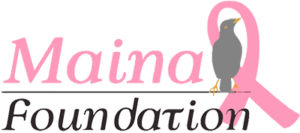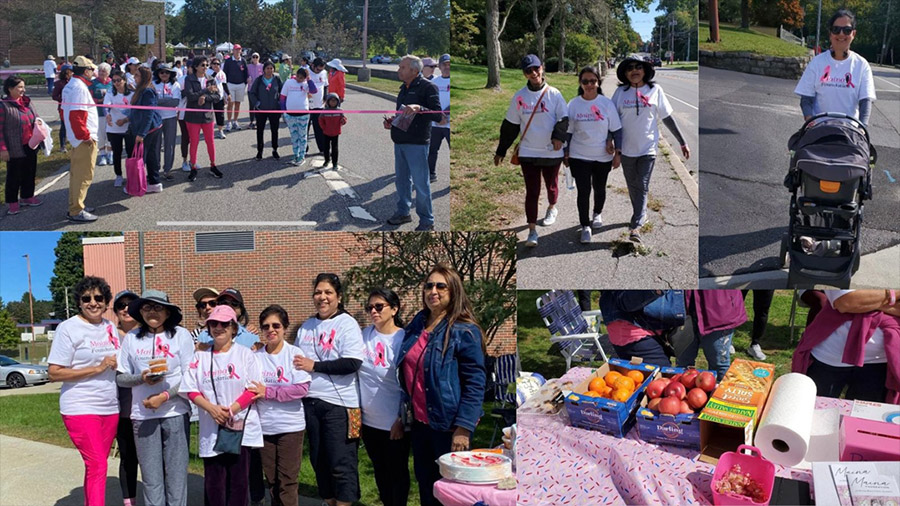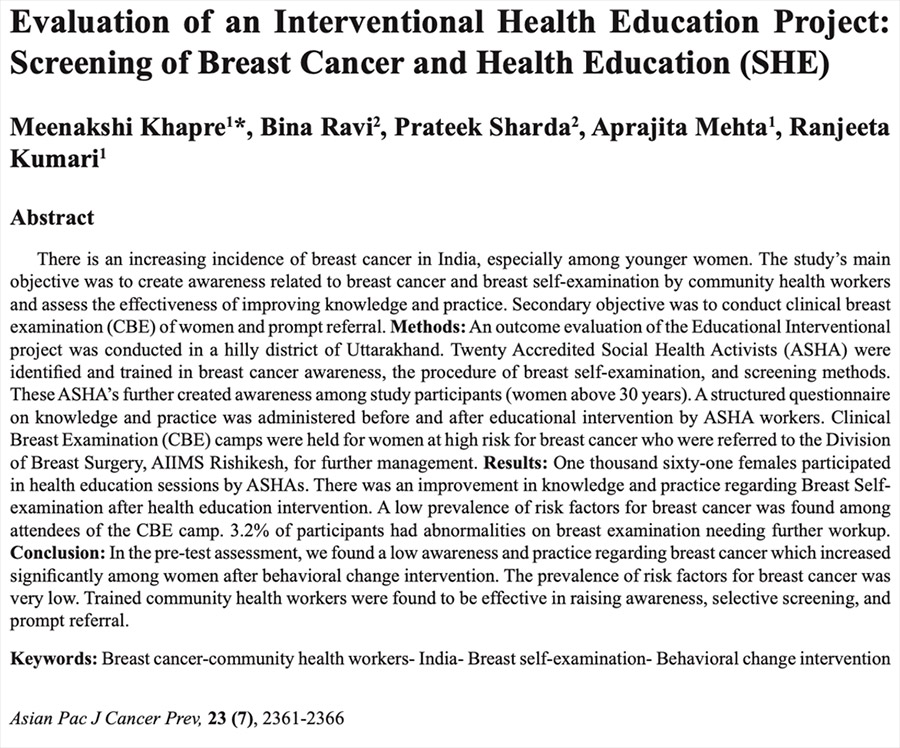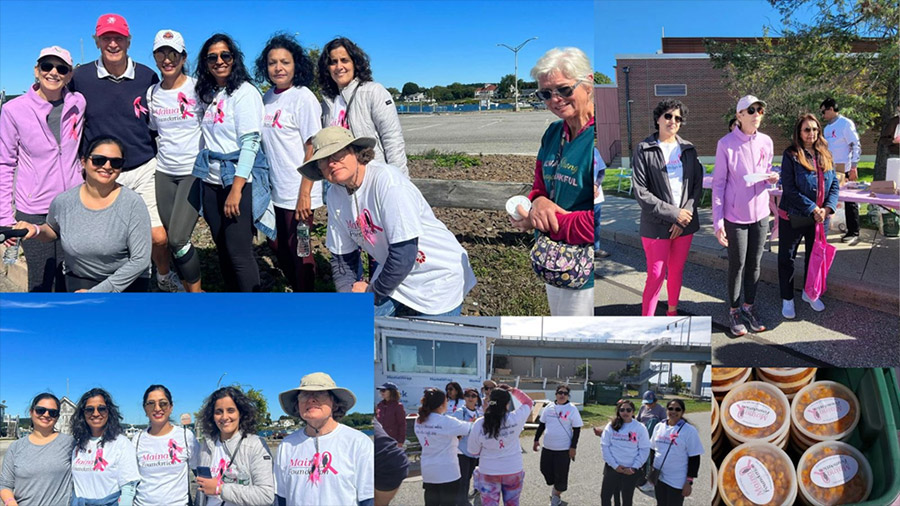
NEWSLETTER
September 2022

Mammograms
By Manju Soni
Welcome to the Maina Foundation Newsletter!
Hi Friends. Fall is here, and with it come all things pumpkin—lattes, muffins, donuts, pies. Oops…I must be hungry :((((
In last month’s newsletter I covered the basics of what is cancer, and in this month’s newsletter I’ll be talking about mammograms and early diagnosis of breast cancer.
And we have some wonderful news to share of the good work Maina Foundation is doing, and some exciting pictures (see above and below) from our Breast Cancer Awareness Walk which took place on 24 September, in Connecticut.
Last month I discussed:
- What is a cell—a gel-filled sac, which has a ‘brain’ called the nucleus that houses the DNA of the cell. Our bodies are made up of trillions of cells. Corruptions of the cell’s DNA are called mutations.
- What is cancer—an uncontrolled growth caused by these DNA mutations that can spread outside of the organ from which it originates.
- What is breast cancer—a cancer that begins from mutations in cells of the lobules and ducts of the breast. It’s common (1 in 8 women have a lifetime risk of developing breast cancer), but it also can be detected, and treated, early, through mammograms.
And lastly, I mentioned my mom’s story of developing breast cancer which did not require chemotherapy, and ten years later she’s still cancer free.
This month we’ll discuss
- Mammograms as a screening tool for breast cancer.
- Breast self-examination, pros and cons.
- Warning signs of breast cancer (in women and men)
I want to stress if you have any concerns whatsoever about your health, you should consult your healthcare provider, this newsletter, and the Internet in general is NOT a doctor. However, it is a good place to gather information, I found the Susan G. Komen website particularly helpful.
Mammograms
When I was around thirteen, my aunt gave me my first bra. I barely had breasts, but oh boy, was I proud of those little plums. I remember going to the movies and feeling like a spotlight was shining on my magnificent new developments. I reminisce about this to make the point that breasts stick OUT. This makes it relatively easy to X-Ray them, that is, to do a mammogram.
Respected national organizations have differing guidelines on when to begin mammograms, and how often to repeat them. This is because there is a downside to screening, and that is overdiagnosis. And overdiagnosis may lead to overtreatment.
Why can mammograms not be 100% accurate? Mammograms can be confusing to read, even for experts, especially in women with dense breasts, which are more common in younger women.
Also, some cancers are very low grade and slow growing, and many of these may disappear spontaneously if left alone without treatment, especially in older women.
But once something suspicious is picked up, both patients and doctors lean towards treatment, thus sometimes, what may have been a harmless opacity on mammograms, is treated, often surgically, as a cancer.
Here is a summary of the guidelines in the USA on when to begin screening and how frequently to do it. Remember, if you have concerns, it’s best to discuss them with your doctor:
|
Women’s Age |
American Cancer Society |
National Comprehensive Cancer Network (NCCN): |
The U.S. Preventive Services Task Force |
|
40-49 years |
starting at age 45. |
starting at age 40. |
Discuss with health care providers about your risk of breast cancer and the pros and cons of mammography. Then, together, make informed decisions. |
|
50-69 years: Benefits better defined in this age group |
|
50-69 years: Every year. |
50-69 years: Every 2 years |
|
70 years and older: benefits balanced against the general health of the patient |
55 and older: Every 1-2 years |
70-74 years: Every 2 years 75 years and older, not enough scientific evidence to recommend for or against routine mammography. In general: if the woman is healthy and still fairly young, mammograms can continue every 1 - 2 years. |
Women’s Age: 40-49 years
American Cancer Society: starting at age 45
National Comprehensive Cancer Network (NCCN): starting at age 40
The U.S. Preventive Services Task Force: Discuss with health care providers about your risk of breast cancer and the pros and cons of mammography. Then, together, make informed decisions.
Women’s Age: 50-69 years: Benefits better defined in this age group
American Cancer Society: 50-54 years: Every year; 55 and older: Every 1-2 years
National Comprehensive Cancer Network (NCCN): 50-69 years: Every year.
The U.S. Preventive Services Task Force: 50-69 years: Every 2 years.
Women’s Age: 70 years and older: benefits balanced against the general health of the patient
American Cancer Society: 55 and older: Every 1-2 years
The U.S. Preventive Services Task Force: 70-74 years: Every 2 years; 75 years and older, not enough scientific evidence to recommend for or against routine mammography. In general: if the woman is healthy and still fairly young, mammograms can continue every 1 - 2 years.
Breast Self-Examination:
Some years back regular breast self-examinations were thought to be a better screening tool than mammograms, especially as self-examination could be done for free, and between annual mammogram visits.
However, since then, a large review by the Cochrane Library asking whether breast self-examination saves lives, concluded that it may not be as helpful as hoped:
- There was no difference in breast cancer survival, and
- Women who did ONLY breast self-examination had more false positive results, that is they were more likely to pick up suspicious masses, which led to nearly twice as many biopsies with negative results (no cancer found).
HOWEVER, it’s still important to know what is normal for you and what is not, especially as there are warning signs of breast cancer you can pick up yourself.
What are the warning signs of breast cancer, in BOTH women and men?
These signs and symptoms need to be attended to should they arise, but also remember these symptoms may also be caused by conditions other than cancer:
- New lump, hard knot or thickening in the breast or underarm (armpit). Remember, don’t panic, most lumps are not breast cancer.
- Swelling, warmth, redness or darkening of the breast
- Irritation, dimpling or puckering of breast skin
- Change in the size or shape of the breast
- Redness or flaky skin in the nipple area or the breast
- Pulling in of the nipple or pain in the nipple area
- Nipple discharge other than breast milk, including blood
- Pain in any area of the breast.
If you have signs or symptoms that worry you, be sure to see your doctor soon.
Thank you for listening to me prattle on!
Manju Soni (she/her) (pen name: M. J. Soni) is a former eye surgeon turned author. She is the author of Defying Apartheid, her debut nonfiction book that captures her experiences of being a young activist against apartheid. Her short fiction and essays has appeared in Ellery Queen Mystery Magazine, Akashic Books, Apeiron Review and The Establishment. She’s a member of Crime Writers of Color and Sisters in Crime (National and Connecticut).
NEWS
A Maina Foundation funded study was published in the Asian Pacific Journal of Cancer Prevention. The abstract follows.

India Development Service (IDS) https://idsusa.org very generously donated $15,000 to Maina Foundation.
Founded in 1974 by a small group of Indians in Chicago who were concerned about the misfortune of their fellow Indians in their home country, IDS was created to support economic and social development in India.
To date, IDS has helped fund more than 200 projects in over 22 states benefiting over 200,000 people through the establishment of education programs, job training, micro-finance lending, health care initiatives, and agricultural support.
Please visit their website to learn more.
EVENTS
We’re excited to share news and pictures from the Maina Foundation Breast Cancer Awareness Walk which took place on 24 September 2022 in Waterford, CT.
It was a perfect fall day with a grand turnout of ~60 participants. Many folk attending the farmer’s market in Waterford Town Hall were made aware of the Maina Foundation and its good work.
Many thanks to everyone who participated, and a special thank you to sponsors:
Nalini Srinivasan who donated aloo parathas, Rekha Odedara who donated choles and who runs Shakahari, an all-vegetarian Indian restaurant in Old Saybrook, Big Y in Old Lyme, CT who donated a gift coupon for water bottles, apples and clementines, Vinu Murdande who brought paper products and Dakshaben for flowers.

SAVE THE DATE – HOLIDAY BOUTIQUE SHOPPING
Shop for the holidays
October 1, 2022
Charlotte, NC
Stay tuned for more details
We thank you for your continued support!
For more information on Maina Foundation, and to help its mission, go to https://mainafoundation.org or contact us at 860-434-3985 or info@mainafoundation.org
SAVE A LIFE - DONATE NOW
Donations can also be mailed to:
8 Peppermint Ridge, Old Lyme, CT 06371, USA
